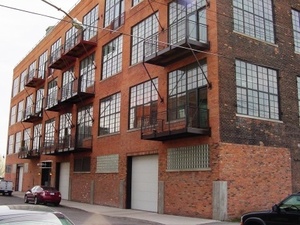(image: http://midtowndetroitinc.org/live/rent/grinnell-place-lofts-unit-303)
The historic Grinnell Warehouse on 2003 Brooklyn was originally a warehouse for multiple businesses, including the Grinnell Brothers piano (and at one point electric car) manufacturers. The Grinnell Place Development company recently renovated the early 1900s building into the Grinnell Place Lofts. They have heavily promoted the connection to the piano manufacturers, even though the warehouse was not owned by Grinnell and it served multiple businesses. The warehouse does not show up on Sanborn Insurance Maps until 1921. According to these maps, the neighborhood was also densely populated in 1921, though with a different mix of uses than today. A Crowley, Milner, and Co. (A Detroit based department store) warehouse was located right next door to the Grinnell warehouse, and a furniture manufacturing plant was across the street. There was a taxicab company located nearby, along with residential housing. Today the area is a mix of residential housing, restaurants, and small businesses and is not too far from the remains of Tiger Stadium at 2121 Trumbull.
The Grinnells used it to store pianos that they manufactured in Holly until they had room to move them into their stores in and around Detroit. Grinnell pianos were only sold in Grinnell owned retailers, but that was not a problem as they had many stores in Detroit and Canada. The main office was located at 1515 Woodward, and the building still stands today. The company likely put their warehouse in Corktown because of the proximity to Michigan Central Station. It would have been a convenient place to store the pianos right next to a train station so they could be shipped easily from Holly and back out to stores. By 1966, Grinnell was the largest music company in the United States, but by 1977, most of the stores closed, and the company went bankrupt in 1981.
The Grinnell brothers entered the business world in 1871 selling organs and sewing machines, but the business really took off once they started manufacturing pianos in 1902. They began with grand pianos and uprights, but eventually started favoring spinets. In an advertisement, they explain this change: “gone are the days of garrish bulk.” They started making smaller and easily movable spinets in order to reduce bulk and accommodate modern homes. Though the Grinnell Place Lofts no longer store pianos, this advertisement is important to the archaeology of the building and company. It indicates that Grinnell was advertising to people living in smaller homes without a dedicated space for a large piano. Their economical price and scale meant they were available to more people than just wealthy people in large homes. People in smaller homes and apartments could now own a piano. Perhaps some of the dwellers in the Grinnell Place Lofts have spinet style pianos.
The history of the Grinnell Place Lofts building might be less exciting than other music manufacturing related buildings in Detroit, but it is important because unlike other a lot of buildings, this one was restored and is currently in use. Detroit is too well known for abandoned buildings and vacant lots, but this building was restored and is fully occupied by residents. Currently, and contrary to national news reports about Detroit, the Corktown neighborhood is a economically viable and densely populated area with many restored historic buildings.
Resources:



